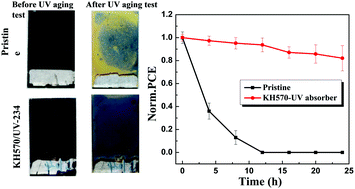Enhanced UV-light stability of organometal halide perovskite solar cells with interface modification and a UV absorption layer†
Abstract
High power conversion efficiency (PCE) and long-term stability against ultraviolet irradiation and humidity for organometal halide perovskite solar cells (Pero-SCs) are challenging factors for the practical application of solar cells. Here, we report a facile strategy to enhance the long-term tolerance of Pero-SCs to UV light. A silane coupling agent was introduced between the electron collection layer and the CH3NH3PbI3 perovskite absorber layer, while an ultraviolet absorber was adopted to block the UV radiation, which is detrimental to the stability of CH3NH3PbI3. This device exhibits excellent performance and chemical stabilities, which result in the loss of 2.2% PCE on average. The unencapsulated devices retain over 80% of their initial efficiency even after continuous UV irradiation for 24 h (at 60% relative humidity), exhibiting greater UV-light tolerance and superior stability. This is a simple and effective approach to fabricate Pero-SCs with enhanced stabilities against UV radiation and the results confirm the influence of UV light on the efficiency, demonstrating a new method for the commercialization of Pero-SCs.



 Please wait while we load your content...
Please wait while we load your content...